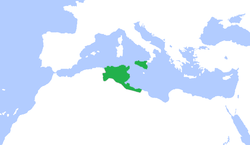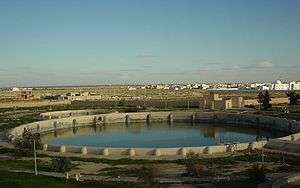Aghlabids
The Aghlabids (Arabic: الأغالبة) were an Arab[6] dynasty of emirs from the Najdi tribe of Banu Tamim, who ruled Ifriqiya and parts of Southern Italy, nominally on behalf of the Abbasid Caliph, for about a century, until overthrown by the new power of the Fatimids.
Aghlabid dynasty of Abbasid Caliphate Banū al-Aghlab (بنو الأغلب) | |||||||
|---|---|---|---|---|---|---|---|
| 800–909 | |||||||
 | |||||||
| Status | Semi-independent emirate, nominally vassal or subject of the Abbasid, but de facto independent since 801.[1][2][3] | ||||||
| Capital | Kairouan | ||||||
| Common languages | Arabic[4] | ||||||
| Religion | Islam (Hanafi, Mu'tazila) | ||||||
| Government | Emirate | ||||||
| Emir | |||||||
• 800–812 | Ibrahim I ibn al-Aghlab ibn Salim | ||||||
• 903–909 | Abu Mudhar Ziyadat Allah III ibn Abdallah | ||||||
| History | |||||||
• Established | 800 | ||||||
• Fatimid overthrown | 909 | ||||||
• Disestablished | 909 | ||||||
| Currency | Aghlabid Dinar[5] | ||||||
| |||||||
| Today part of | Algeria Tunisia Libya Malta Italy | ||||||
| Historical Arab states and dynasties | ||||||||||||||||||||||||||||||||||||||||||||||||||||||||||
|---|---|---|---|---|---|---|---|---|---|---|---|---|---|---|---|---|---|---|---|---|---|---|---|---|---|---|---|---|---|---|---|---|---|---|---|---|---|---|---|---|---|---|---|---|---|---|---|---|---|---|---|---|---|---|---|---|---|---|
 | ||||||||||||||||||||||||||||||||||||||||||||||||||||||||||
|
Ancient Arab States
|
||||||||||||||||||||||||||||||||||||||||||||||||||||||||||
|
Arab Empires
|
||||||||||||||||||||||||||||||||||||||||||||||||||||||||||
|
Eastern Dynasties
|
||||||||||||||||||||||||||||||||||||||||||||||||||||||||||
|
Western Dynasties
|
||||||||||||||||||||||||||||||||||||||||||||||||||||||||||
|
Arabian Peninsula
|
||||||||||||||||||||||||||||||||||||||||||||||||||||||||||
|
East Africa
|
||||||||||||||||||||||||||||||||||||||||||||||||||||||||||
|
Current monarchies
|
||||||||||||||||||||||||||||||||||||||||||||||||||||||||||
Part of a series on the |
||||||||||||||
|---|---|---|---|---|---|---|---|---|---|---|---|---|---|---|
| History of Tunisia | ||||||||||||||
 | ||||||||||||||
|
Prehistoric |
||||||||||||||
|
Ancient
|
||||||||||||||
|
|
||||||||||||||
|
||||||||||||||
|
| ||||||||||||||
Part of a series on the |
|---|
| History of Algeria |
 |
|
Prehistory
|
|
|
|
Modern times Ottoman Algeria (16th - 19th centuries)
French Algeria (19th - 20th centuries)
|
|
Contemporary era |
|
Related topics
|

.jpg)
History
In 800, the Abbasid Caliph Harun al-Rashid appointed Ibrahim I ibn al-Aghlab, son of a Khurasanian Arab commander from the Banu Tamim tribe,[7] as hereditary Emir of Ifriqiya as a response to the anarchy that had reigned in that province following the fall of the Muhallabids. At that time there were perhaps 100,000 Arabs living in Ifriqiya, although the Berbers still constituted the great majority.[8]
Ibrahim was to control an area that encompassed eastern Algeria, Tunisia and Tripolitania.[9] Although independent in all but name, his dynasty never ceased to recognise Abbasid overlordship. The Aghlabids paid an annual tribute to the Abbasid Caliph and their suzerainty was referenced in the khutba at Friday prayers.[10]
After the pacification of the country Ibrahim ibn al-Aghlab established a residence at a new capital, al-Abbasiyya, which was founded outside Kairouan, partly to distance himself from the opposition of the Malikite jurists and theologians, who condemned what they saw as the luxurious life of the Aghlabids (not to mention the fact that the Aghlabids were mu'tazilites in theology, and Hanafis in fiqh-jurisprudence), and disliked the unequal treatment of the Muslim Berbers. Additionally, border defenses (ribat) were set up in Sousse and Monastir. The Aghlabids also built up the irrigation of the area and enhanced the public buildings and mosques of[9] al-‘Abbāsiyya. It was recorded that 5,000 black Zanj slaves were used which were supplied via trans-Saharan trade.[11]
One unique feature of the Aghlabids is that despite the political differences and rivalry between Aghlabids, who served under the Abbasid Caliphate, and the Umayyad Emirate of Cordoba, the Muslims in Spain also sent a fleet under Asba' ibn Wakil to aid the Aghlabid conquest of Sicily (see Muslim conquest of Sicily). Ibn Kathir recorded that a joint force of 300 Umayyad and Aghlabid ships were present.[12] The Aghlabid garrison at Mineo managed to get into contact with the Andalusian Umayyads, who immediately agreed to the alliance, provided that Asbagh was recognized as the overall commander, and, together with fresh troops from Ifriqiya, they marched on Mineo. Theodotus retreated to Enna and the siege of Mineo was broken in July or August 830.[13][14][15] The combined Ifriqiyan and Andalusian army then torched Mineo and laid siege to another town, possibly Calloniana (modern Barrafranca). However, a plague broke out in their camp, causing the death of Asbagh and many others. The town fell later, in autumn, but the Arabs' numbers were depleted to the point where they were forced to abandon it and retreat west. Theodotus launched a pursuit and inflicted heavy casualties, and, thereafter, most of the Andalusians departed the island. However, Theodotus too was killed at this time, possibly in one of these skirmishes.[16][17]
Under Ziyadat Allah I (817–838) came a revolt of Arab troops in 824, which was not quelled until 836 with the help of the Berbers. The conquest of Byzantine Sicily from 827 under Asad ibn al-Furat was an attempt to keep the unruly troops under control – it was only achieved slowly, and only in 902 was the last Byzantine outpost taken. Plundering raids into mainland Italy, which included the sack of Rome, Naples and Bari by Muhammad Abul Abbas of Sicily,[18] took place until well into the 10th century. Gradually the Aghlabids lost control of the Arab forces in Sicily and a new dynasty, the Kalbids, emerged there.
The Aghlabid kingdom reached its high point under Ahmad ibn Muhammad al-Aghlabi (856–863). Ifriqiya was a significant economic power thanks to its fertile agriculture, aided by the expansion of the Roman irrigation system. It became the focal point of trade between the Islamic world and Byzantium and Italy, especially the lucrative slave trade. Kairuan (Kairouan) became the most important centre of learning in the Maghreb, most notably in the fields of theology and law, and a gathering place for poets. The Aghlabid emirs also sponsored building projects, notably the rebuilding of the Mosque of Uqba and the kingdom developed an architectural style which combined Abbasid and Byzantine architecture.[19]
Decline of the Aghlabids
The decline of the dynasty began under Ibrahim II ibn Ahmad (875–902). An attack by the Tulunids of Egypt had to be repelled and a revolt of the Berbers put down with much loss of life. In addition, in 893 there began amongst the Kutama Berbers the movement of the Shiite Fatimids to overthrow the Aghlabids. Abdullah al-Mahdi Billah captured the cities of Qairawan and Raqqada and took an oath of allegiance from the people. By 909, the Aghlabid Dynasty was overthrown and replaced with the Fatimids.[20]
Aghlabid rulers
- Ibrahim I ibn al-Aghlab ibn Salim (800–812)
- Abdallah I ibn Ibrahim (812–817)
- Ziyadat Allah I ibn Ibrahim (817–838)
- al-Aghlab Abu Iqal ibn Ibrahim (838–841)
- Abu 'l-Abbas Muhammad I ibn al-Aghlab Abi Affan (841–856)
- Ahmad ibn Muhammad al-Aghlabi (856–863)
- Ziyadat Allah II ibn Abil-Abbas (863)
- Abu 'l-Gharaniq Muhammad II ibn Ahmad (863–875)
- Abu Ishaq Ibrahim II ibn Ahmad (875–902)
- Abu 'l-Abbas Abdallah II ibn Ibrahim (902–903)
- Abu Mudhar Ziyadat Allah III ibn Abdallah (903–909)
See also
- History of Islam in southern Italy
- History of medieval Tunisia
- List of Sunni Muslim dynasties
- History of Algeria
- History of Libya
Citations
- Historical Dictionary of Algeria – Phillip C. Naylor
- Libya. Ediz. Inglese – Anthony Ham
- Islam: An Illustrated History – Greville Stewart Parker Freeman-Grenville, Stuart Christopher Munro-Hay
- Versteegh 1997, p. 209.
- Logistics of Warfare in the Age of the Crusades: Proceedings of a Workshop – John H. Pryor, p187
- C.E. Bosworth, The New Islamic Dynasties, (Columbia University Press, 1996), 31.
- C.E. Bosworth, The New Islamic Dynasties, 31.
- Julien, Histoire de L'Afrique du Nord (Paris: Payor 1931; revised by de Tourneau 1952), translated as History of North Africa (London: Routledge & Kegan Paul 1970; New York: Praeger 1970) at 42.
- Goldschmidt, Arthur (2002). A concise history of the Middle East. Boulder, Colorado: Westview Press. pp. 79. ISBN 0-8133-3885-9.
- Laroui, The History of the Maghrib (1970, 1977) at 116.
- Lev, Yaacov (1991). State and Society in Fatimid Egypt (Volume 1 dari Arab history and civilization. Studies and texts: 0925-2908 ed.). BRILL. p. 5. ISBN 9004093443.
- El Hareir, Mbaye, Idris, Ravane (2011). The Spread of Islam Throughout the World. UNESCO. p. 441. ISBN 9231041533.
- Bury (1912), p. 304
- Treadgold (1988), pp. 273–274
- Vasiliev (1935), pp. 127–128
- Treadgold (1988), p. 274
- Vasiliev (1935), pp. 128–129
- Barbara M. Kreutz, Before the Normans: Southern Italy in the Ninth and Tenth Centuries, (University of Pennsylvania Press, 1991), 26-27.
- "Aghlabids". Dictionary of Islamic Architecture. Archnet. Archived from the original on 29 June 2011. Retrieved 23 January 2011.
- Najeebabadi, Akbar (2001). The History of Islam V.3. Riyadh: Darussalam. p. 235. ISBN 978-9960-89293-1.
References
- Georges Marçais, "Aghlabids," Encyclopedia of Islam, 2nd ed., Vol. I, pp. 699–700.
- Mohamed Talbi, Emirat Aghlabide, Paris: Adrien Maisonneuve, 1967.
- Maurice Vonderheyden, La Berbérie orientale sous la dynastie des Benoû l-Aṛlab, 800–909, Paris: Geuthner, 1927.
- Versteegh, Kees (1997). The Arabic Language. Columbia University Press.CS1 maint: ref=harv (link)